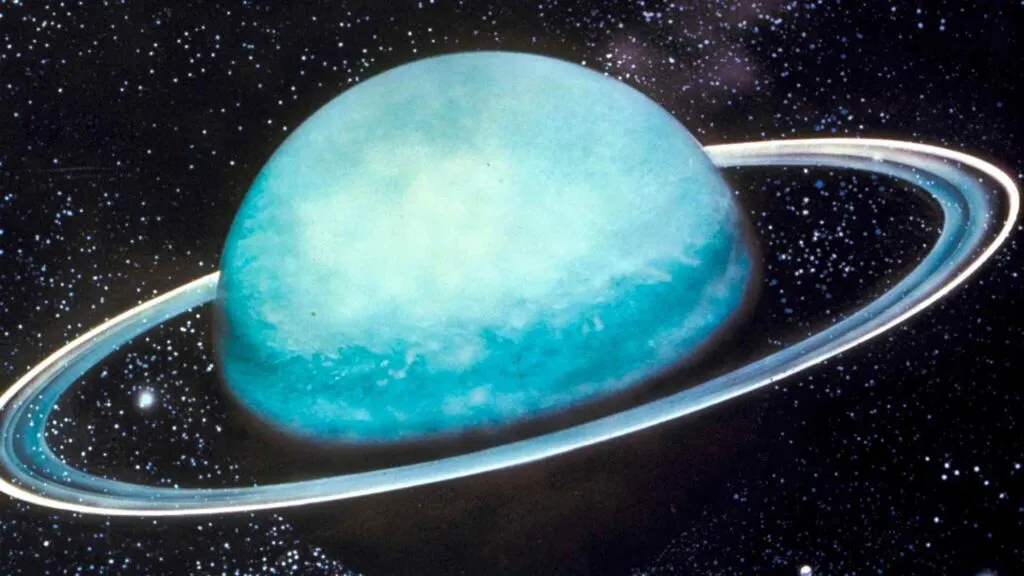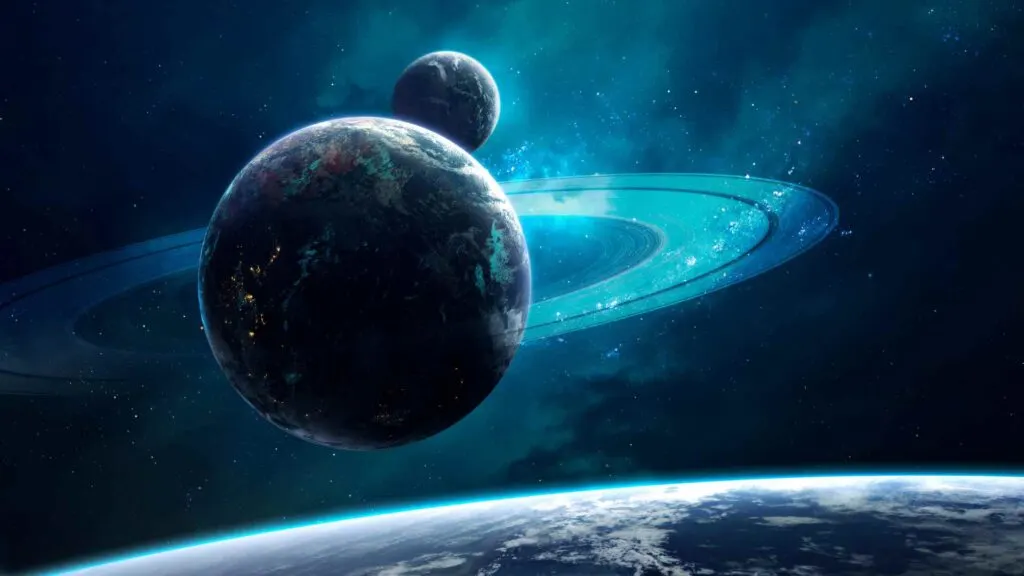Uranus, the seventh planet from the Sun, has captivated scientists and space lovers alike. With its unique tilt, icy rings, and a mysterious atmosphere, Uranus stands out among the planets.
This guide dives into over 145 fun facts about Uranus, exploring every intriguing detail of this blue-green giant.
The Basics of Uranus
- Uranus is the seventh planet from the Sun, located 1.8 billion miles away.
- Known as an “ice giant,” Uranus consists primarily of water, ammonia, and methane ices.
- Uranus was the first planet discovered with a telescope in 1781 by William Herschel.
- It has a diameter of 31,518 miles, making it the third-largest planet in our Solar System.
- Uranus’ atmosphere gives it a pale blue color, thanks to methane absorbing red light.
- Uranus orbits the Sun at an average distance of 1.8 billion miles.
- It is four times wider than Earth, though Earth could fit into Uranus about 63 times.
- With a mass 14.5 times that of Earth, Uranus is one of the least dense planets.
- Its gravity is only slightly weaker than Earth’s, at about 89% of Earth’s gravity.
- Uranus is 14 times more massive than Earth but not as massive as Jupiter or Saturn.
- The planet is named after the Greek god of the sky, Ouranos.
- Uranus was initially thought to be a star, rather than a planet.
- Herschel wanted to name Uranus “Georgium Sidus” after King George III.
- Uranus has no solid surface; it is made mostly of swirling fluids.
- Uranus has a magnetosphere similar to that of Earth, but tilted at a unique angle.

The Atmosphere of Uranus
- Uranus’ atmosphere is composed primarily of hydrogen and helium, with traces of methane.
- The methane in Uranus’ atmosphere is what gives it a blue-green hue.
- There is a possibility of diamond rain deep within the atmosphere of Uranus.
- Uranus has clouds that form layers, with water clouds likely deeper within the atmosphere.
- The outer atmosphere of Uranus contains hydrocarbons, which form from methane.
- Winds in Uranus’ atmosphere can reach speeds of up to 560 miles per hour.
- Uranus has the coldest planetary atmosphere in the Solar System, reaching -371°F.
- There are seasonal changes in Uranus’ atmosphere, with storms that appear and disappear.
- Uranus lacks the striking banding patterns seen on Jupiter and Saturn.
- The planet’s atmosphere contains haze, giving it a very subtle appearance.
- Scientists have detected auroras on Uranus, similar to Earth’s Northern Lights.
- The atmosphere on Uranus is denser than the one on Neptune, despite similar compositions.
- Uranus’ clouds are often described as “hazy” and hard to see with regular telescopes.
- Methane clouds occasionally appear high up in the atmosphere of Uranus.
- The composition of Uranus’ atmosphere leads to unique chemical reactions due to low temperatures.
Uranus’ Rings
- Uranus has 13 known rings, though they are faint and challenging to see.
- The rings of Uranus were discovered in 1977, well after Saturn’s rings were known.
- The rings are primarily composed of dark particles, likely icy with some rocky material.
- The two brightest rings of Uranus are named the Epsilon and Delta rings.
- Some of Uranus’ rings are only a few kilometers wide.
- The rings are unusually dark, reflecting very little sunlight compared to other planetary rings.
- Scientists believe Uranus’ rings may be young, possibly only 600 million years old.
- The rings are divided into inner and outer rings, with the outer rings being brighter.
- Uranus’ faint rings are occasionally replenished by material from its moons.
- Uranus’ rings have clumps, with particles that sometimes cluster together.
- Voyager 2 captured the first detailed images of Uranus’ rings in 1986.
- The rings contain tiny dust particles mixed in with larger chunks of ice.
- Some rings of Uranus are named after famous astronomers, like the Herschel Ring.
- The Epsilon ring of Uranus is the densest and most prominent ring.
- There may be undiscovered rings around Uranus, hidden in the faint outer areas.

Uranus’ Moons
- Uranus has 27 known moons, all named after characters from literature.
- The largest moons are Titania, Oberon, Umbriel, Ariel, and Miranda.
- Titania, the largest moon, has a diameter of around 980 miles.
- Uranus’ moons are among the darkest objects in the Solar System.
- Each moon of Uranus is unique in shape and surface features.
- Miranda, a moon of Uranus, has one of the most unusual surfaces in the Solar System.
- The moons of Uranus orbit the planet at various angles, influenced by its tilt.
- Ariel, one of Uranus’ moons, has many bright areas, hinting at geologic activity.
- Some moons have significant geological features, like rifts and valleys.
- Umbriel, one of the darkest moons, is covered in an unknown dark material.
- Uranus’ moons are believed to contain water ice beneath their crusts.
- The orbits of the moons of Uranus are synchronous, showing the same face to the planet.
- Each moon of Uranus has unique characteristics that set them apart.
- Titania and Oberon are thought to possibly have subsurface oceans.
- The five largest moons of Uranus might be old fragments from a larger moon.
Orbit and Rotation of Uranus
- Uranus takes 84 Earth years to complete a single orbit around the Sun.
- A day on Uranus lasts around 17 hours and 14 minutes.
- Uranus orbits the Sun on its side, rotating nearly perpendicular to its orbit.
- The tilt of Uranus is about 98 degrees, making it the most tilted planet in the Solar System.
- Due to its extreme tilt, Uranus experiences extreme seasons lasting about 21 Earth years each.
- During parts of its orbit, one pole of Uranus faces the Sun for decades.
- The tilted rotation of Uranus is believed to result from a massive collision.
- Uranus’ orbit around the Sun is slightly elliptical, taking it closer and farther away.
- The rotational axis of Uranus causes unusual day-night cycles on the planet.
- Seasons on Uranus are unlike those on any other planet in the Solar System.
- Because of its orbit, Uranus goes from one equinox to another in 42 Earth years.
- When viewed from Earth, Uranus’ orbit looks almost circular.
- Voyager 2 passed Uranus at a speed of 40,000 miles per hour, capturing data.
- The rotational tilt of Uranus affects the movement of its magnetic field.
- Uranus’ unique orbit contributes to its magnetic field’s tilted orientation.

Temperature and Climate of Uranus
- Uranus is known for having the coldest temperatures of any planet in the Solar System.
- The average temperature on Uranus is around -353°F.
- Temperatures in Uranus’ atmosphere can drop as low as -371°F.
- Despite being farther from the Sun, Neptune is warmer than Uranus.
- Scientists speculate that Uranus might have a very cold core.
- There are occasional heat outbursts on Uranus, causing transient storms.
- Seasonal changes on Uranus result in temperature fluctuations across hemispheres.
- Uranus’ cold atmosphere is due to it radiating very little heat from its core.
- The extreme temperatures on Uranus make it an unlikely place for life as we know it.
- Uranus lacks the internal heat that other planets like Jupiter and Saturn have.
- Uranus is sometimes called an “ice giant” due to its cold, icy atmosphere.
- Clouds on Uranus are frozen methane, contributing to its extremely low temperatures.
- Scientists believe Uranus has a layer of liquid water and ammonia beneath its clouds.
- Wind speeds on Uranus reach up to 560 miles per hour despite the cold climate.
- Seasonal storms appear on Uranus, especially as it nears its equinox.
The Discovery of Uranus
- William Herschel discovered Uranus on March 13, 1781.
- Herschel initially thought he had discovered a comet, not a planet.
- Uranus is the first planet discovered in modern times.
- Its discovery expanded the known boundaries of our Solar System.
- After its discovery, Uranus led astronomers to consider the existence of Neptune.
- Uranus was first cataloged as a star by astronomers before Herschel’s discovery.
- Herschel proposed calling it “Georgium Sidus,” or “George’s Star.”
- Uranus helped revolutionize the study of planetary orbits.
- The discovery of Uranus led to advancements in telescope technology.
- Johann Elert Bode named Uranus after a mythological figure.
- Its unusual orbit eventually led to Neptune’s discovery in 1846.
- Uranus was identified with the help of early astronomical charts.
- Its discovery marked a new era of planetary studies.
- Herschel was knighted for his contributions to astronomy.
- Uranus’ discovery was accidental, made during a survey of the night sky.
Unique Features of Uranus
- Uranus has a unique 98-degree axial tilt, unlike any other planet.
- Its magnetic field is tilted 59 degrees relative to its rotation axis.
- Uranus’ magnetic field is offset from the planet’s center.
- Scientists believe Uranus once suffered a massive collision.
- It has some of the strongest winds in the Solar System, despite its cold atmosphere.
- Uranus is referred to as an “ice giant,” distinct from “gas giants” like Jupiter.
- The planet’s tilt means it essentially rolls around its orbit.
- Scientists theorize that diamond rain could occur on Uranus.
- Uranus does not have visible storm bands like Jupiter and Saturn.
- Uranus’ poles are near the equator compared to other planets.
- Its blue-green color comes from methane gas in the upper atmosphere.
- There is speculation that Uranus could have vast oceans beneath its atmosphere.
- Uranus has seasons lasting over 20 Earth years due to its tilted rotation.
- Its atmospheric structure differs greatly from both Jupiter and Saturn.
- Uranus emits very little heat compared to other giant planets.
Uranus in Popular Culture
- Uranus often appears in sci-fi literature as a mysterious world.
- The planet’s name has been a source of humor due to its pronunciation.
- Uranus was featured in Carl Sagan’s famous series Cosmos.
- The planet appears in the famous video game franchise Mass Effect.
- Uranus was a destination in the animated series Futurama.
- Popular sci-fi author Isaac Asimov referenced Uranus in his writings.
- Uranus was a key focus in Arthur C. Clarke’s novel 2061: Odyssey Three.
- The odd tilt of Uranus inspired plot elements in several novels.
- Uranus appears in Star Trek, which explores the Solar System’s planets.
- Due to its rings, Uranus is compared to Saturn in some stories.
- The unique magnetic field of Uranus has sparked theories in fiction.
- In astrology, Uranus represents sudden changes and innovation.
- Uranus’ cold temperatures and harsh climate appear in survival-themed sci-fi.
- The planet’s name led to wordplay in The Simpsons series.
- Scientists hope a new mission to Uranus will inspire future cultural references.
Bonus Facts About Uranus
- Uranus’ discovery was one of the first major breakthroughs in modern astronomy.
- Uranus’ north and south poles are essentially where its equator should be.
- The rings of Uranus were one of the biggest astronomical surprises of the 20th century.
- Astronomers still know relatively little about the inner workings of Uranus.
- The rings of Uranus are vastly different from those around Saturn.
- Uranus might have liquid water layers within its icy interior.
- The Epsilon ring of Uranus changes in brightness as it orbits.
- Voyager 2 is the only spacecraft to have visited Uranus, in 1986.
- Uranus has one of the strangest axial tilts in the Solar System.
- The atmosphere of Uranus is likely poisonous to humans due to methane.
- Uranus emits a faint, ghostly light in certain images.
- The planet is largely unexplored, with a single visit by Voyager.
- Aurora phenomena have been observed at Uranus’ poles.
- Uranus’ rings occasionally fade in and out of visibility.
- Some astronomers think a future mission to Uranus is overdue.
